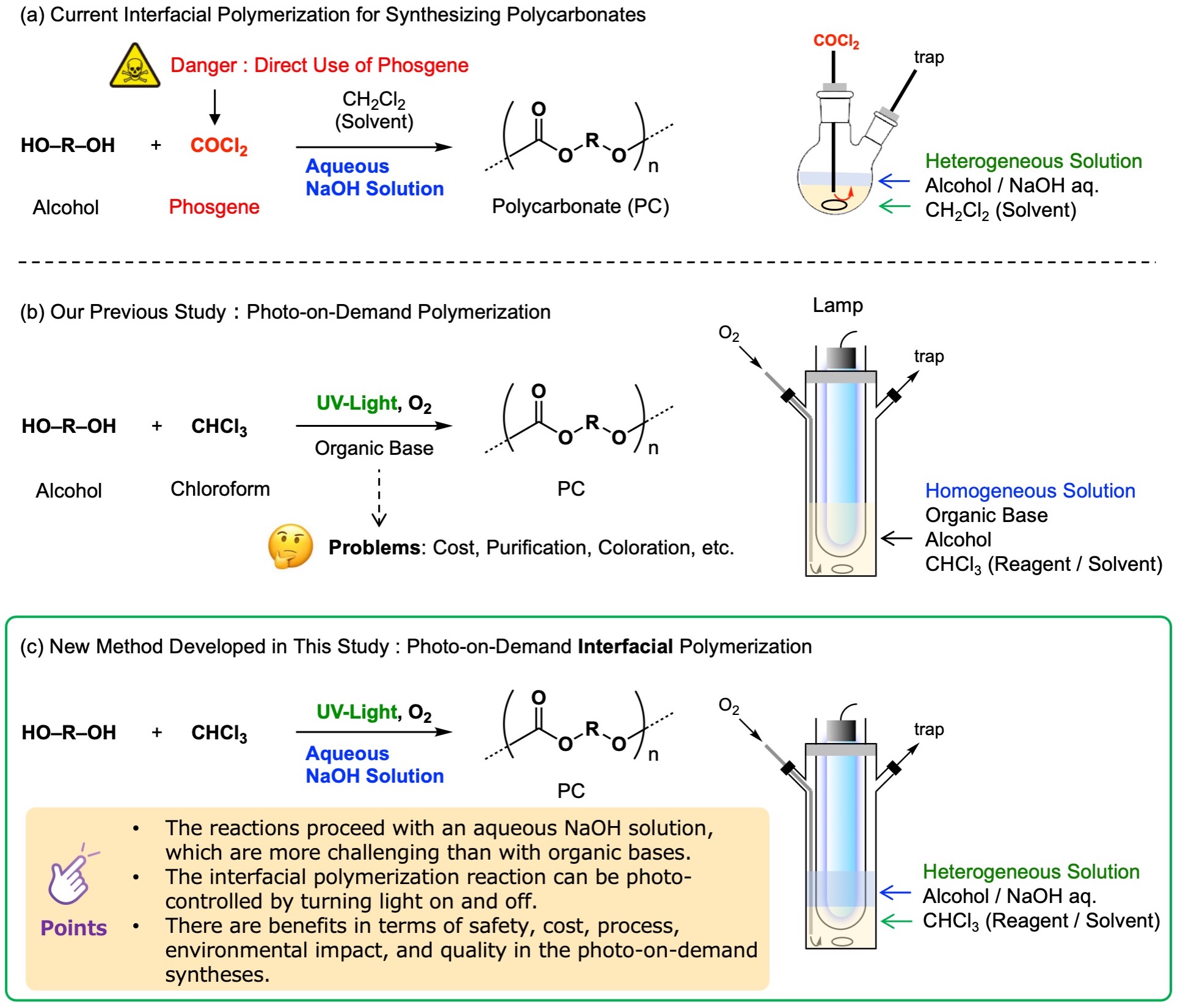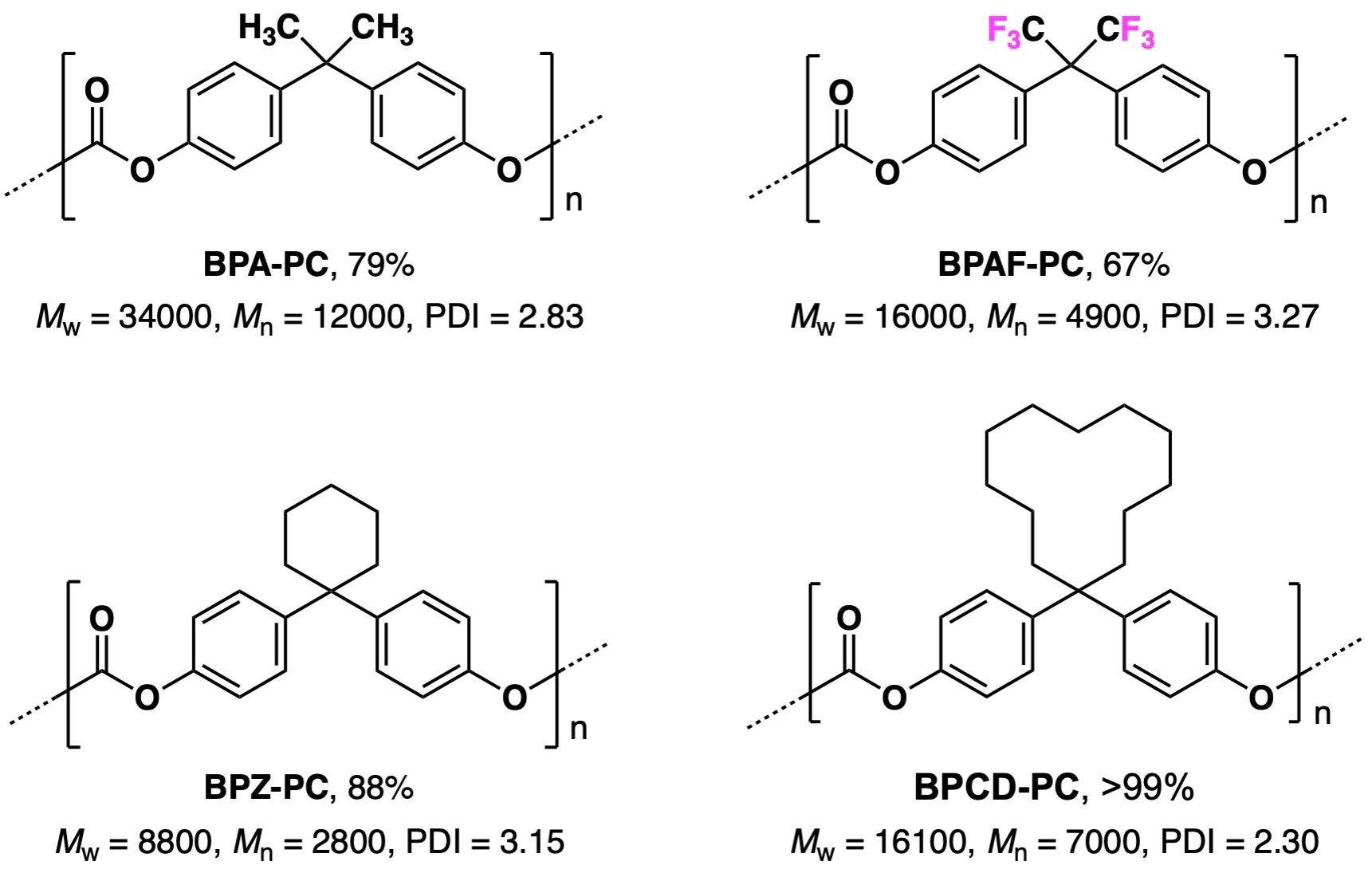As an engineering plastic having high transparency and impact resistance, polycarbonate (PC) is employed in eyeglass lenses, camera lenses, DVDs, automobile headlights and bulletproof glass. The industrial production thereof is mainly performed by means of interfacial polymerization reacting highly reactive phosgene with alcohol at the interface of water and an organic solvent. However, because phosgene is extremely toxic, a synthesis method not employing it has been actively studied from the perspective of safety. In recent years, phosgene substitutes (diphenyl carbonate, etc.) has been employed in the synthesis of relatively low molecular weight PC, but for the manufacture of high-grade PC with a large molecular weight, there was no alternative to using the conventionally very-more-reactive phosgene. With the objective of developing a new chemical reaction enabling the synthesis of safe, inexpensive, simple and low environmental load carbonates, the research group of Associate Professor Akihiko TSUDA of Kobe University Graduate School of Science has worked on the development of an interfacial polymerization reaction by means of the photo-on-demand organic synthesis method developed by that same group. They discovered that when ultraviolet light was shone on a mixed solution of aqueous sodium hydroxide, chloroform and alcohol (in a three-phase separated state of the gaseous phase, aqueous phase and the organic phase), while oxygen gas is being bubbled through it, a reaction is generated at the interfaces and the target polycarbonate could be obtained at a high-yield. This new method is suitable to the small-scale synthesis of a wide range of carbonate products.
The research team has obtained patents on the photo-on-demand interfacial synthesis method of carbonates in USA, Singapore, Japan, China, Germany and eight other countries. Furthermore, a technical paper relating to this study was published on ACS Omega (American chemical Society) webpage on July 18 2023.

Main points
- The research team succeeded in synthesizing carbonates safely, inexpensively, simply and with a low environmental load by merely shining ultraviolet light on a mixed solution of commercially available chloroform, alcohol and an aqueous solution of sodium hydroxide.
- Generally, because an aqueous solution of sodium hydroxide breaks down both chloroform and phosgene, and while it would be expected to prevent reactions, surprisingly contrary to that expectation, the reaction was promoted.
- Currently, most polycarbonates are manufactured by reacting phosgene gas with alcohol. In the synthesis method described here there is no need to directly handle phosgene, because the required amount of phosgene is generated by irradiating the light to the chloroform solvent.
- The research team succeeded in synthesizing four types of commercially available carbonate, three types of fluorinated carbonate (used as a phosgene substitute), three types of general use polycarbonate, one type of a specific fluorinated polycarbonate and six types of urea derivatives.
- Whereas the conventional method employing phosgene directly is preferred to large-scale production of a small variety of carbonates, this synthesis method is preferred to the production of a wide variety of polycarbonates on a small scale.
- This could contribute to the implementation of a carbon-neutral and sustainable society with low CO2 emissions, energy consumption and wastes.
- This study was supported by Adaptable and Seamless Technology Transfer Program Through Target Driven R&D (JST A-STEP SEED Oriented Results)
Background of the research
Phosgene (COCl2) is used as the raw material for pharmaceutical intermediates and polymers. The worldwide phosgene market continues to increase at a scale of several percentage points per year at present, with 8 - 9 million tons produced annually. However, because it is highly toxic, there are active studies on the development of compounds and chemical reactions which can replace it for safety reasons. The research group of Associate Professor Akihiko Tsuda discovered for the first time that when ultraviolet light is shone on the chloroform solvent, the photochemical oxidation occured to produce phosgene with high efficiency (Patent number 5900920). Furthermore, the research team discovered a synthetic method in which the reaction substrates and catalysts for reacting with phosgene are dissolved in chloroform in advance, and when phosgene is generated by irradiating with light, they react immediately to give the product. (Patent No. 6057449). This method enables the implementation of organic synthesis using phosgene, while apparently not adding phosgene. This research team named that effect "the photo-on-demand organic synthesis method", and succeeded in synthesizing a great number of useful organic chemicals and polymers. When compared with the conventional direct handling of phosgene, the photo-on-demand organic synthesis method features safety and economy, as well as a low environmental load, and is receiving a lot of attention currently from industry and academia as a next-generation novel chemical synthesis method. A number of chemical reactions using phosgene are known and used in industrial production. The research team has currently discovered that the photo-on-demand organic synthesis method can be used in most of these chemical reactions, and continues that research, while actively announcing that activity in journal articles, conferences and to mass media.
Content of the Research
This study employs a heterogenous solution mixing alcohol, chloroform (CHCl3) and an aqueous sodium hydroxide (NaOH) solution, traversing the three phases of a gaseous phase, an aqueous phase and an organic phase, and succeeded in developing a new photo-on-demand interfacial reaction. Using this photochemical reaction, the research team succeeded to synthesize carbonates from aromatic alcohols, and polycarbonates (PC) from aromatic diols, enabling a safe and practical scale, high-yield, simple, inexpensive and low environmental load synthesis (FIG. 1, Reaction (c); FIG. 2). Compared with some of the reactions in a homogenous solution using organic bases developed previously by this research team (FIG. 1, Reaction (b)), there are the benefits that synthesis costs can be reduced, savings can be made in the purification, as well as suppressing the discoloration of the products.
The photochemical oxidation of chloroform to phosgene could be triggered by vigorously stirring the sample solution under oxygen bubbling and irradiating both the gas and liquid phases with UV light from a low-pressure mercury lamp. Because an aqueous solution of sodium hydroxide (NaOH) generally decomposes chloroform and phosgene, it could be expected to prevent the reaction, but surprisingly, it promotes the reaction, contrary to that expectation. It is thought that because the solution is separated into the two phases of the aqueous phase on the organic phase, the decomposition is suppressed, and the reaction is promoted.
It is expected that the alcohol and water competitively react with the generated phosgene in situ, at the interface of the organic phase/aqueous phase and the aqueous phase/gaseous phase, generating carbonate. The highly volatile alkyl alcohols diffused in the gaseous phase did not cause the reactions, but carbonates were obtained at a high yield from commercially available aromatic alcohols and diols having electron-donating and electron-withdrawing substituents.
Most of the industrial production of polycarbonate is currently performed by the interfacial polymerization method using phosgene directly (FIG. 1, Reaction (a)). The method described here avoids the direct handling of that dangerous phosgene, and is an innovative and practical chemical reaction enabling the synthesis of polycarbonate by a photo-on-demand interfacial synthesis reaction of chloroform and alcohol.


Future developments
The photo-on-demand organic synthesis method can be used in most carbonate synthesis using phosgene. Moreover, it enables the synthesis of specialized carbonates and functional polycarbonates and the like where there was a reluctance conventionally to handle highly toxic reagents. By this means, a variety of elements and functional groups can be arbitrarily introduced to carbonate compounds, achieving high performance and high functionality at the molecular level of pharmaceuticals and polymer materials, which can be expected to lead to the development of more creative and highly novel, high added-value products. The current method directly employing phosgene is preferred to large-scale industrial production of a small variety of products, on the other hand the method described here is preferred to small-scale production of a wide variety of chemical products and should prove very attractive for small- and medium-scale chemical manufacturers. The research team has established a Kobe University initiated venture enterprise, producing original chemical products and is in receipt of orders for synthesis and it is expected that it will develop into licensing business.
Acknowledgements
This research was supported and implemented with the help of the Adaptable and Seamless Technology Transfer Program Through Target Driven R&D program (JST A-STEP SEED Oriented Results) of the research topic "The development of high functionality/high added-value polyurethane materials by means of a safe manufacture process using fluorine-containing carbonates as key intermediates" (Research representative: Akihiko Tsuda)
Patent Information
[1] Title of the invention: Carbonate derivative production method
Patent filing in Japan: Japanese patent application 2017-097681 (Filing date: 16th of May 2017)
International patent application: PCT/JP2018/017348 (Filing date 27th of April 2018)
Unexamined publication: WO 2018/211952 A1 (Publication date: 22nd of November 2018)
Patent registration status: US patent 11130728, Singapore 11201909670Y, Japan 7041925, China ZL 201880032021.8, Russia 2771748, Europe 3626702 (Germany 602018046202.3 Registration and progress: Italy, France, UK, Belgium, Spain), Saudi Arabia (registration and process), South Korea 10-2542131
Inventor: Akihiko Tsuda
Patent applicant: Kobe University and one other
[2] Title of the invention: Fluorinated carbonate derivative production method
Patent filing in Japan: Japanese patent application 2017-097682 (16th of May 2017)
International patent application: PCT/JP2018/017349 (Filing date: 27th April 2018)
Unexamined publication: WO 2018/211953 A1 (Publication date: 22nd Nov. 2018)
Patent registration status: US patent 11167259, Japanese patent 7054096
Inventor: Akihiko Tsuda
Patent applicant: Kobe University and one other
[3] Title of the invention: Manufacture method of polycarbonate
Patent filing in Japan: Japanese patent application 2018-214976 (Filing date: 15th of November 2018)
International patent application: PCT/JP2019/044686 (Filing date: 14 November 2019)
Unexamined publication: WO 2020/100975 A1 (Publication date: 22nd of May 2022
Patent registration status: China (Registration in process), Russia (Registration in process)
Inventor: Akihiko Tsuda
Patent applicant: Kobe University and one other
Original publication
Tsuda et al.: Photo-on-Demand in situ Phosgenation Reactions that Cross Three Phases of a Heterogeneous Solution of Chloroform and Aqueous NaOH. ACS Omega (2023). DOI: doi.org/10.1021/acsomega.3c04290






